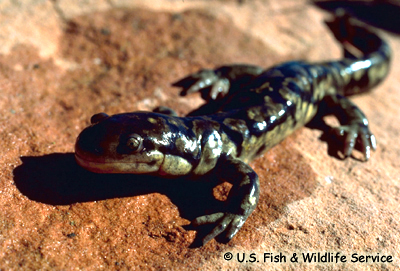Tiger Salamander
Great Lakes population
|
|
| Scientific name: |
Ambystoma tigrinum |
| Taxonomic group: |
Amphibians |
| Range: |
ON |
| |
| Status under SARA*: |
Extirpated, on Schedule 1
|
Last COSEWIC**
designation: |
Extirpated (November 2001) |
*SARA: The Species at Risk Act
**COSEWIC: The Committee on the Status of Endangered Wildlife in Canada |
Quick Links: |
Photo |
Description |
Habitat |
Biology |
Reasons for extirpation |
Protection |
National Recovery Program |
Top
|
Description
The terrestrial adult is usually 200-300 mm in length and 40-70 g in weight. It has a primarily dark olive to dark grey or brown background colour with lighter olive to yellow spots. Newly hatched larvae measure 9-15 mm in length, are silvery grey, and have three pairs of feathery external gills.
Top
|
|
Distribution and Population
The species is widely distributed across North America. It occurs from the mixed-wood and boreal forests of Alberta and Saskatchewan to the north, down to Mexico in the south. In Canada, it is found in British Columbia, Alberta, Saskatchewan and Manitoba. The Great Lakes population occurred in southern Ontario, but the species has not been seen there since 1915, when it was recorded in Point Pelee National Park.
Top
|
|
Habitat
The species occurs in montane, aspen parkland and grassland regions. Key habitat features include friable soil for burrowing, fishless semi-permanent to permanent water bodies for breeding, and possibly small mammal burrows for daily cover and suitable overwintering sites.
Top
|
|
Biology
Shortly after hatching, larvae first begin to grow their front limbs, followed by the development of the hind limbs. In the presence of high larval densities, especially when there is a whole range of larval body sizes in the larvae population, cannibalistic larvae may develop, eating other salamander larvae, including individuals as large as themselves. During metamorphosis, larvae resorb their gills as well as their caudal and dorsal fin membranes. Sometimes, certain individuals do not undergo metamorphosis, but become sexually mature in larval form. These adults are referred to as neotenes. Both types of adults may be found in a single population, although a given population is usually composed predominantly of either neotenic adults or terrestrial adults.
Top
|
|
Reasons for extirpation
Major threats to Tiger Salamanders mirror those faced by many other amphibians. In particular, Tiger Salamanders face loss of upland habitat due to encroachment and roads, and loss of breeding habitat due to fish stocking, chemical run-off, and draining of wetlands. There is some evidence that Tiger Salamanders are philopatric, therefore destruction of a breeding site may result in loss of the entire population using that breeding site.Two major groups of pathogens (Chytrid fungi and Iridoviruses) have been isolated from Tiger Salamanders in Canada, but their significance to the overall health of populations is not yet understood.
Top
|
|
Protection
The Tiger Salamander Great Lakes population is protected under the federal Species at Risk Act (SARA). More information about SARA, including how it protects individual species, is available in the Species at Risk Act: A Guide.
|
|
|
|


